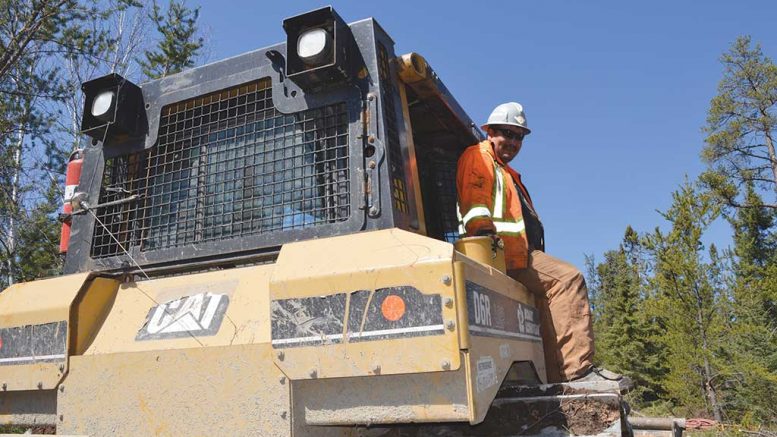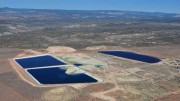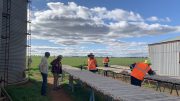While mining is best known for supplying the world with precious and base metals, technology metals – such as lithium, cobalt and transition metals – are needed for advanced applications, such as electric vehicle batteries, superalloys and within consumer electronics. Below, we provide an overview of eight juniors with exposure to these elements.
Auxico Resources
Auxico Resources (CNSX: AUAG) is an exploration-stage company with mineral assets in Brazil, Colombia and Mexico.
In June, Auxico signed a joint venture agreement with Kibara Minerals to concentrate and export tantalum- and niobium-bearing materials from the Democratic Republic of the Congo (DRC). Kibara has a supply agreement in place with a cooperative for purchase of tantalite material from an artisanal site in the north-central part of the country. Auxico, together with its partner, Covemin (a European commodities trading firm), has established relationships with potential buyers of this mineral product. Auxico would purchase and ship the material, retaining 70% of the profits and Kibara would retain 30%.
Towards the end of June, the company closed a $1.6-million non-brokered private placement of convertible debentures. Net proceeds are intended to start the trading process out of the DRC and Brazil, as well as for general working capital.
In February 2019, Auxico signed a memorandum of understanding (MOU) with a Brazil-based company to earn a 70% interest in a joint venture on the 41-sq.-km Palha property in the country. Samples from the site returned up to 50.7% niobium, 90.2% tin, 3.1% tantalum and 700 grams per tonne scandium.
By July of last year, the company announced that it had entered into an additional option agreement – this time, to acquire a 100% interest in the 7.4-sq.-km Porto Grande property in Brazil’s Amapa state for a total of US$2 million. The site has exploration and export permits in place for gold, tin, tantalum and niobium — occurrences of the last three elements have been documented at the property. Porto Grande lies within the country’s Gleba-Matapi tantalum-niobium, gold and tin district.
In Colombia, Auxico has 20 agreements in place with coltan (niobium-tantalum) property owners in the Vichada and Guainia departments. In January 2019, the company announced that its sampling campaign at the optioned PanaPana property in Colombia’s Guainia state discovered up to 4.6 kg per tonne of scandium, 417.7 kg of niobium, 323.1 kg of tantalum and up to 495.6 kg per tonne of titanium. A total of four samples were extracted from black sands over an area of 500 metres by 1,500 metres.
Auxico Resources has a $3.8-million market capitalization.
Avalon Advanced Materials

Senior geologist Chris Pedersen in a core shack at Avalon Advanced Materials’ Separation Rapids lithium project near Kenora, Ontario. Credit: Avalon Advanced Materials.
Avalon Advanced Materials‘ (TSXV: AVL) most advanced asset is the Separation Rapids lithium project, 70 km north of Kenora, Ontario.
The site features measured and indicated resources of 8.1 million tonnes grading 1.37% lithium oxide and 0.36% rubidium oxide and inferred resources of 1.2 million tonnes at 1.33% lithium oxide and 0.36% rubidium oxide. The deposit is petalite-enriched. The lithium-bearing mineral is a desirable feed for specialty glass-ceramic products due to its low impurity levels and potential to generate high-purity lithium products at relatively low costs for manufacturers of rechargeable lithium-ion batteries.
In 2018, the company completed a preliminary economic assessment for the project, which suggests a 20-year, 475,000 tonne-per-year operation, producing 71,500 tonnes per year of petalite and 11,800 tonnes of lepidolite annually. With an initial capital outlay of $77.7 million, the after-tax net present value estimate for the development, at an 8% discount rate, came in at US$102.2 million, with a 22.7% internal rate of return.
In June, the company announced that it had received the approvals to extract a 2,500-tonne bulk sample, which would be processed at a pilot plant to recover petalite samples for testing by interested glass and ceramic companies. Recent laboratory work on samples from Separation Rapids has focused on flowsheet optimization for an efficient production of petalite products. The company plans to complete a feasibility study for the asset once offtake agreements are in place.
Avalon is also evaluating potential minerals recovery opportunities from historical wastes at closed mines. Precision Periodic, a private U.S.-based company, is working with Avalon to develop a new extraction technology, which would be used to recover dissolved elements from acid mine drainage using nano-filtration.
Avalon’s wholly owned, past-producing East Kemptville tin-indium project in Nova Scotia features a stacked tailings facility, generating acidic runoff with a high content of target metals. The company’s vision for the site includes first processing low-grade stockpiles with ore-sorting technology, followed by a reprocessing of the tailings to recover the dissolved metals.
Avalon Advanced Materials has an $18.6-million market capitalization.
First Cobalt

First Cobalt’s cobalt refinery in northern Ontario. Credit: First Cobalt.
First Cobalt (TSX: FCC) is working to become North America’s first producer of battery-grade cobalt through a restart of its First Cobalt refinery in Ontario, the only primary cobalt refinery on the continent.
In May, the company released the results of a feasibility study on a restart of the facility, which would involve an expansion of the refinery and adapting it to produce cobalt sulphate for the electric vehicle battery market.
The feasibility outlines a 25,000 tonne-per-year (55 tonne per day) battery-grade cobalt sulphate production scenario, which, according to the company, would supply 5% of the world’s refined cobalt. The project would produce cobalt sulphate at a minimum grade of 20.5% cobalt at total operating costs of US$2.72 per lb. cobalt. With an initial capital requirement of US$56 million, the feasibility derived an after-tax net present value estimate of US$139 million, at an 8% discount rate, with a 53% internal rate of return.
The company is working to develop a demonstration plant, which could produce cobalt sulphate by the fourth quarter of this year, and aims to restart the refinery at 55 tonnes per day by late 2021.
Shortly after the feasibility release, First Cobalt also announced a $2.1-million work program for the refinery, to investigate additional opportunities to improve the project economics.
In tandem with the feasibility, the company also tabled a prefeasibility level evaluation of a restart of the refinery at a 12 tonne per day throughput as a benchmark for potential restart scenarios. Three scoping studies are underway to evaluate alternate startup options.
First Cobalt plans to use the prefeasibility and scoping study results to determine an optimal restart strategy. According to the company, the option outlined in the prefeasibility document supports a startup of the refinery using existing permits, facilities and equipment, with some changes to the current flowsheet and plant modifications.
In July 2019, First Cobalt and Glencore (LSE: GLEN) entered into a partnership agreement, which would provide a non-dilutive and fully funded approach to restart the refinery. As part of this agreement, First Cobalt would treat cobalt feed from Glencore’s operations in the Democratic Republic of the Congo for an initial term of up to four-and-a-half years, and Glencore would provide up to 100% of the capital required to restart and expand the refinery.
In Idaho, the company also holds the Iron Creek project, with indicated resources of 2.2 million tonnes at 0.32% cobalt-equivalent and a further 2.7 million tonnes at 0.28% cobalt-equivalent inferred. Contained cobalt stands at 12.3 million lb. in the indicated and 12.7 million lb. in the inferred category.
First Cobalt has a $48.8-million market capitalization.
Freeport Resources
Freeport Resources (TSXV: FRI) is an exploration company with mineral assets in Labrador and British Columbia.
The company’s most advanced assets are the Hutton Garnet beaches deposits in Labrador, 350 km north of Nain. These cover 28 sq. km and, according to Freeport, are some of the highest-grade known placer garnet deposits in the world.
Measured and indicated resources at Hutton stand at 918,000 tonnes per metre depth, containing a total of 1.3 million tonnes of garnet. These resources are made up of onshore and offshore components, with contributions from the South and North Beaches as well as from the Seven Islands. Offshore resources have an estimated depth of one metre; the onshore component is projected over two metres – the North Beach is 27% garnet by weight while the South is 63% garnet.
The company envisions a seasonal operation producing 20,000 tonnes of garnet product annually at Hutton, with an extraction scenario similar to a small-scale sand and gravel mine. Based on removing thin layers of sand from the beach, Freeport expects the environmental impact of the mine to be minimal.
Freeport has environmental assessment approval to extract a 5,000-tonne bulk sample at Hutton. The sample would be used to fine-tune the processing flowsheet, finalize the plant design and generate garnet products for market testing and, ultimately, outline a commercial production scenario. According to the company, the processing requirements for the Hutton deposits are low-intensity in terms of the equipment and capital costs required.
Freeport also holds the 1.5-sq.-km Spanish Mountain Gold property in B.C., which is adjacent to and on strike with Spanish Mountain Gold’s (TSXV: SPA) pre-development gold project. Also in the province, the company owns 12-sq.-km of Q claims, prospective for fluorspar and molybdenite, as well as the past-producing tungsten-gold Red Rose mine.
Freeport Resources has a $14.5-million market capitalization.
Frontier Lithium

Frontier Lithium Inc.’s VP Exploration Garth Drever (left) and President & CEO Trevor R. Walker examine core from the PAK lithium deposit in northwestern Ontario, representing 155 metres of world-class, technical grade, low-iron spodumene. Credit: Frontier Lithium Inc.
Frontier Lithium (TSXV: FL) is advancing its wholly owned Pak lithium project in northwestern Ontario, 175 km north of Red Lake. The 268-sq.-km Pak project includes the Spark and Pak deposits. In 2018, the company released the results of a feasibility study on Pak.
The Pak site lies along Ontario’s ‘Electric Avenue’ within the Canadian Shield, which spans hundreds of kilometres and features rare metals occurrences. The Pak deposit is at the southwestern end of this trend.
According to the company, its Pak project, at surface, hosts the highest quality spodumene lithium hard rock resource in North America. The lithium resource quality is based on low levels of impurities (such as iron) as well as its high grades and volumes.
In May, Frontier reported metallurgical results from an ore composite extracted from Pak. Third-party testing generated a high-quality spodumene concentrate with an average grade of 7.2% lithium oxide with low impurities. According to Frontier, these results compare favourably with the specifications from the world’s primary source of technical-grade spodumene concentrates.
In February, Frontier tabled a maiden pit-constrained resource estimate for the Spark pegmatite at Pak: this deposit includes an indicated resource of 3.2 million tonnes grading 1.59% lithium oxide, containing 51,712 tonnes of the compound, with a further 12.2 million inferred tonnes, at 1.36% lithium oxide, totalling an additional 166,177 tonnes of lithium oxide.
At the Pak deposit, measured and indicated resources total 8.5 million tonnes at 1.78% lithium oxide, with a further 1.9 million tonnes inferred grading 2.01% lithium oxide.
In 2018, the company released the results of a preliminary feasibility study on a combined open-pit and underground development of the Pak deposit. The 1,090-tonne-per-day, 16-year operation would produce a total of 1.1 million tonnes of technical grade lithium concentrate (grading 7.2% lithium oxide) and 115,500 tonnes of chemical-grade lithium concentrate (at 6.6% lithium oxide) over its lifespan. With a pre-production capital cost estimate of $147 million, the after-tax net present value estimate for the mine, at an 8% discount rate, came in at $301 million, with a 38.3% internal rate of return.
Frontier is working towards first producing premium technical-grade lithium concentrates for glass producers and aims to scale up towards lithium chemical production for the glass and battery materials markets by building a downstream processing facility.
Frontier Lithium has a $33.8-million market capitalization.
Grid Metals
Grid Metals (TSXV: GRDM) has a 100% interest in the East Bull Lake (EBL) property, 80 km west of Sudbury, Ontario. The 22-km long by 4-km layered intrusion includes near-surface palladium mineralization along its southern and northern margins. Grid has held the property for over 20 years and collected a significant exploration database over that time, including the results of geophysical surveys and the results from 5,000 samples.
Grid suggests geological analogies between EBL and Impala Platinum’s (JSE: IMP) Lac des Iles palladium complex in northwestern Ontario. The prospective structures at EBL cover a strike length of 30 km with potential for vertical feeder structures with higher-grade palladium-rich sulphide mineralization.
In May, the company completed a magnetotelluric (MT) survey over EBL — a new approach to exploration at the site – to help trace zones of palladium-rich sulphide mineralization.
At the Parisien Lake area in the centre of the property, this survey outlined a large anomaly at a depth of 450 metres, nearby two large-scale faults.
Two additional scout MT lines completed around the northern margin of the EBL intrusion traced a strong anomaly along its northern contact. No drilling has been done to date along this 7-km long horizon. At the East Lobe area on the eastern end of EBL, the MT survey defined an additional large prospective structure.
By June, Grid announced that it had started drilling at EBL, with 5,000 metres planned in nine diamond drill holes across three target areas within the EBL intrusion. The first stage will be at Parisien Lake and the second will test geophysical anomalies around the margins of the East and West Lobe intrusions.
In addition, Grid holds the Makwa-Mayville nickel-copper-palladium project in Manitoba, 145 km from Winnipeg. This asset consists of the nickel-dominant Makwa holding and the copper-dominant Mayville property; the two are located 40 km apart. A preliminary economic assessment completed in 2014 envisions two open pit mines. The study proposes an 8,300-tonne-per-day, 14-year operation, at an initial capital cost of $208 million, with a post-tax net present value estimate, at a 7.5% discount rate, of $97 million.
Total indicated resources across the two projects consist of 33.8 million tonnes grading 0.27% nickel, 0.37% copper, 0.06 gram platinum and 0.19 gram palladium. Additional total inferred resources stand at 5.9 million tonnes at 0.2% nickel, 0.43% copper, 0.06 gram platinum and 0.15 gram palladium.
Grid Metals has an $11.9-million market capitalization.
SRG Mining
SRG Mining (TSXV: SRG) is focused on developing the wholly owned Lola graphite deposit in Guinea, 1,000 km southeast of Conakry. Last year, the company released the results of a feasibility study for the project, which outlines total proven and probable reserves of 42 million tonnes grading 4.17% carbon graphite for a total of 1.75 million tonnes contained graphite.
The feasibility suggests an open pit operation with a 29-year mine life, producing an average of 54,600 tonnes of graphite flakes a year. Based on an average concentrate grade of 95.4% carbon graphite, the site plant would be designed to produce 50,000 tonnes of concentrate annually in four standard size fractions and recovered through a conventional flotation process. Based on an initial capital cost estimate of US$123 million and life-of-mine average operating costs pegged at US$508 per tonne of concentrate, the associated after-tax net present value estimate for the project, at an 8% discount rate, would be US$159 million with a 21.2% internal rate of return.
In July, the company closed a $1-million private placement, with proceeds intended for development of Lola and general working capital requirements.
In June, SRG announced that it has signed its sixth off-take agreement for Lola, encompassing 8,000 tonnes of graphite over a three-year period. With this announcement, 90% of the company’s forecast production over the first three years of operations is now under a sales agreement.
This April, the company announced that it has selected DRA Global as the provider of engineering, procurement and construction management (EPCM) services for Lola, with the site-based work to be led by DRA’s African subsidiary.
Last summer, SRG also entered into a share purchase agreement with a U.S.-based industrial firm, where the latter acquired US$5 million of SRG stock and entered into a memorandum of understanding (MOU) with the company to jointly investigate cooperation possibilities in areas such as debt financing, energy production and concentrate transportation. In November of 2019, SRG received the mining permit for Lola for a renewable 15-year term.
SRG Mining has a $55.9-million market capitalization.
Western Magnesium

Credit: Western Magnesium.
Western Magnesium (TSXV: WMG) is working to become a producer of magnesium, based on its proprietary technology, which uses a continuous silicon and high-temperature reaction to produce the metal. According to the company, this flowsheet features low labour and energy cost requirements and does not generate toxic by-products or waste, and aims to overcome many of the limitations of current magnesium batch extraction processes.
Although magnesium is an abundant metal, it poses a supply challenge due to limitations in its extraction and production. Current processes either have a measureable environmental impact or are high-cost and labour-intensive.
In April, the company announced that it has started the build-out of its first commercial magnesium pilot plant and aims to produce magnesium from the plant by the end of this year. Western Magnesium plans to then send this metal out for industry tests and certifications and to ultimately collect market demand and purchase order data by the third quarter of 2021. The market data would be used to size the company’s first commercial facility.
Based on a corporate update from early June, the process engineering for the pilot plant is complete. The company has engaged a mechanical engineering firm to provide detailed equipment designs and models, and long lead-time items will be designed first to maintain the project schedule. Western Magnesium is procuring long-lead items concurrently with the design work. Once the company secures a facility for the pilot plant, it then plans to select a construction engineering firm.
In November 2019, the company signed a three-year capital commitment with New York-based GEM Global Yield, which would make $210 million available to the company as it works towards commercial production of high-grade magnesium.
In Nevada, Western Magnesium has 100% control over the unpatented claims of the Tami Mosi magnesium property, 10 km southeast of Ely. A 2011 resource estimate for the site outlined 412 million inferred tonnes grading 12.3% magnesium, containing 111 billion pounds of magnesium.
Western Magnesium has a $37.5-million market capitalization.





Be the first to comment on "Technology Metals Snapshot: Eight juniors developing next generation metals"